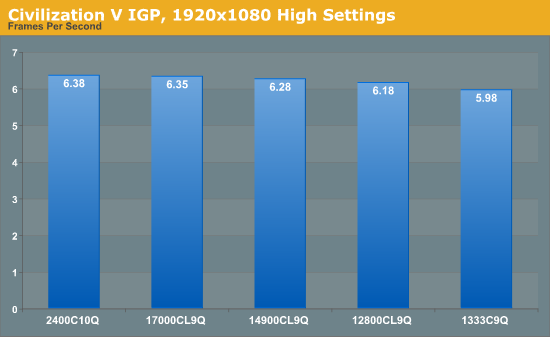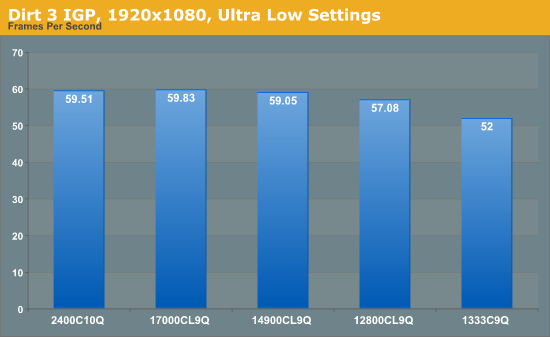Memory Performance: 16GB DDR3-1333 to DDR3-2400 on Ivy Bridge IGP with G.Skill
by Ian Cutress on October 18, 2012 12:00 PM EST- Posted in
- Memory
- G.Skill
- Ivy Bridge
- DDR3
Metro2033
Metro2033 is a DX11 benchmark that challenges every system that tries to run it at any high-end settings. Developed by 4A Games and released in March 2010, we use the inbuilt DirectX 11 Frontline benchmark to test the hardware at 1920x1080 with full graphical settings. Results are given as the average frame rate from 4 runs.

While comparing graphical results in the 5 FPS range may not seem appropriate, it taxes the system to its fullest, exposing whether at this high end memory actually makes a difference or if we are weighing on computation. What we do see is a gradual increase in frame rate with each kit, up to 10% difference between the top end and the bottom kit. The pivotal point of increase is from 1333 to 1866 – beyond 1866 our increases are smaller despite the increased cost of those kits.
Civilization V
Civilization V is a strategy video game that utilizes a significant number of the latest GPU features and software advances. Using the in-game benchmark, we run Civilization V at 1920x1080 with full graphical settings, similar to Ryan in his GPU testing functionality. Results reported by the benchmark are the total number of frames in sixty seconds, which we normalize to frames per second.

In comparison to Metro2033, Civilization V does not merit a large % increase with memory kit, moving from 3% to 6.7% up the memory kits. Again we do this test with all the eye candy enabled to really stress the CPU and IGP as much as we can to find out where faster memory will help.
Dirt 3
Dirt 3 is a rallying video game and the third in the Dirt series of the Colin McRae Rally series, developed and published by Codemasters. Using the in game benchmark, Dirt 3 is run at 1920x1080 with Ultra Low graphical settings. Results are reported as the average frame rate across four runs.

In contrast to our previous tests, this one we run at 1080p with ultra-low graphical settings. This allows for more applicable frame rates, where the focus will be on processing pixels rather than post-processing with effects. In previous testing on the motherboard side, we have seen that Dirt3 seems to love every form of speed increase possible – CPU speed, GPU speed, and as we can see here, memory speed. Almost every upgrade to the system will give a better frame rate. Moving from 1333 to 1600 gives us almost a 10% FPS increase, whereas 1333 to 1866 gives just under 15%. We peak at 15% with the 2133 kit, but this reinforces the idea that choosing a 1600 C9 kit over a 1333 C9 kit is a no brainer for the price difference. Choosing that 1866 C9 kit looks like a good idea, but the 2133 C9 kit is reaching the law of diminishing returns.










114 Comments
View All Comments
jwilliams4200 - Friday, October 19, 2012 - link
You are also incorrect, as well as highly misleading to anyone who cares about practical matters regarding DRAM latencies.Reasonable people are interested in, for example, the fact that reading all the bytes on a DRAM page takes significantly less time than reading the same number of bytes from random locations distributed throughout the DRAM module.
Reasonable people can easily understand someone calling that difference sequential and random read speeds.
Your argument is equivalent to saying that no, you did not shoot the guy, the gun shot him, and you are innocent. No reasonable person cares about such specious reasoning.
hsir - Friday, October 26, 2012 - link
jwilliams4200 is absolutely right.People who care about practical memory performance worry about the inherent non-uniformity in DRAM access latencies and the factors that prevent efficient DRAM bandwidth utilization. In other words, just row-cycle time (tRC) and the pin bandwidth numbers are not even remotely sufficient to speculate how your DRAM system will perform.
DRAM access latencies are also significantly impacted by the memory controller's scheduling policy - i.e. how it prioritizes one DRAM request over another. Row-hit maximization policies, write-draining parameters and access type (if this is a cpu/gpu/dma request) will all affect latencies and DRAM bandwidth utilization. So just sweeping everything under the carpet by saying that every access to DRAM takes the same amount of time is, well, just not right.
nafhan - Friday, October 19, 2012 - link
I was specifically responding to your incorrect definition of "random access". Randomness doesn't guarantee timing; it just means you can get to it out of order.jwilliams4200 - Friday, October 19, 2012 - link
And yet, by any practical definition, you are incorrect and the author is correct.For example, if you read (from RAM) 1GiB of data in sequential order of memory addresses, it will be significantly faster than if you read 1GiB of data, one byte at a time, from randomly selected memory addresses. The latter will usually take two to four times as long (or worse).
It is not unreasonable to refer to that as the difference between sequential and random reads.
Your argument reminds me of the little boy who, chastised by his mother for pulling the cat's tail, whined, "I didn't pull the cat's tail, I just held it and the cat pulled."
jwilliams4200 - Thursday, October 18, 2012 - link
Depending on whether there is a page-hit (row needed already open), page-empty (row needed not yet open), or page-miss (row needed is not the row already open), the time to read a word can vary by a factor of 3 times (i.e., 1x latency for a page-hit, 2x latency for a page-empty, and 3x latency for a page-miss).What the author refers to as a "sequential read" probably probably refers to reading from an already open page (page-hit).
While his terminology may be ambiguous (and his computation for the "sequential read" is incorrect, it should be 4 clocks), he is nevertheless talking about a meaningful concept related to variation on latency in DRAM for different types of reads.
See here for more detail:
http://www.anandtech.com/show/3851/everything-you-...
Shadow_k - Thursday, October 18, 2012 - link
My knowledge of RAM has increased 10 fold very nice artical well donelosttsol - Thursday, October 18, 2012 - link
2133MHz "Recommended for Deeper Pockets"???Not really. DDR3 is so cheap now that high end RAM is affordable for all. I would have said you were crazy a few years ago if you told me soon I could buy 16GB of RAM for less than $150.
IanCutress - Thursday, October 18, 2012 - link
Either pay $95 for 1866 C9 or $130 for 2133 C9 - minor differences, but $35 saving. This is strictly talking about the kits used today, there could be other price differences. But I stand by my recommendation - for the vast majority of cases 1866 C9 will be fine, and there is a minor performance gain in some scenarios with 2133 C9, but at a $35 difference it is hard to justify unless you have some spare budget. Most likely that budget could be put into a bigger SSD or GPU.Ian
just4U - Friday, October 19, 2012 - link
Something has to be said about the TridentX brand I believe.. since it is getting some pretty killer feedback. It's simply the best ram out there being able to do all that any other ram can and that little bit extra. I don't see the speed increase as a selling point but the lower timings at conventional speeds that users are reporting is interesting.. I haven't tried it though.. just going on what I've read. Shame about the size of the heatsinks though.. makes it problematic in some builds.Peanutsrevenge - Friday, October 19, 2012 - link
You clearly live in some protected bubble where everyone has well paid jobs and isn't on a shoestring budget.I would so LMAO when you get mugged by someone struggling to feed themselves because you're all flash with your cash.